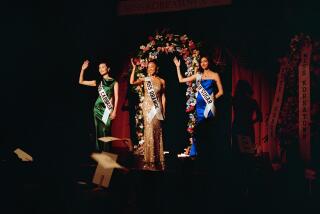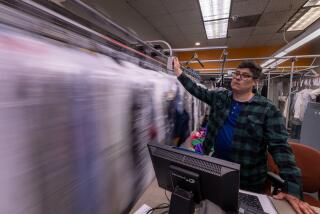Anxiety builds as crime increases in Koreatown
H.J. Huh arrived in Koreatown a decade ago, as the district was struggling to recover from the 1992 Los Angeles riots.
The nurse from South Korea has seen the area blossom with fancy restaurants, luxury health spas and high-end condos.
But Huh says she has never felt less safe.
First, a rapist stalked the neighborhood, attacking more than a dozen women. That was followed by several robberies and shootings.
Now, she tries to stay in her apartment at night, even avoiding a quick trip to the nearby Korean supermarket. When a stranger enters her apartment elevator, she gets off at a different floor to make sure she is not followed home.
“I am afraid to go out -- even to a market at night,” she said. “Koreatown is one of the densest areas in the city, but you hardly see patrol cars.”
To the casual eye, Koreatown is thriving -- with luxury condominiums and extravagant nightclubs rising from the destruction of the riots. During his Asian trade mission earlier this month, Mayor Antonio Villaraigosa announced $300 million in South Korean investment in Koreatown, including a Korean Trade and Cultural Center, new offices for the South Korean Consulate and a Korean American Museum.
But behind the glitz, anxiety is building.
A series of high-profile slayings in the community over the last year -- including the shooting deaths of three people at a Koreatown restaurant earlier this month -- have heightened concerns about crime.
Los Angeles Police Department statistics underscore the perception, showing a 40% jump in homicides (from 15 to 21) and 11% increase in robberies (from 557 to 620) in Koreatown so far this year. Rapes in the district are up 47% -- from 30 to 44.
In response, the Korean American Federation next month will begin citizen security patrols on weekend nights, using a car purchased by the community organization. Additionally, some Korean churches and senior groups are urging first-generation immigrants, accustomed to transacting business in cash back home, to carry minimal cash so they will be less of a target for robbers.
The fear, said Gab Jea Cho, a federation board member in charge of the community security project, is that the crime issue could make Koreatown a less attractive place for South Koreans to invest in and visit. A good amount of the area’s growth is being financed through investments by wealthy South Koreans, who also have made Koreatown a major tourist draw.
Visitors from South Korea are the best customers at exclusive stores, snatching up designer mink coats, watches, jewelry and leather goods before heading for the airport to return home.
“Tourists from South Korea will stop coming if they keep hearing about crime in Koreatown,” said Chris Moon Key Nam, a real estate agent who recently was elected president of the federation.
Among some Korean Americans, concerns about crime are already changing behavior.
“I don’t go to Koreatown when the sun goes down,” said Suky Lee, a real estate agent with Nelson Shelton & Associates in Beverly Hills. “I don’t feel comfortable.”
*
Police and community leaders are quick to point out that while violent crime is up in Koreatown this year, overall crime is down compared with the mid-1990s, as it is in the rest of Los Angeles. Assaults declined from 410 incidents last year to 340 so far this year.
But the perception of crime has become a central issue in Koreatown -- fueled by several violent incidents that have generated much coverage in both the Korean-language and mainstream news media.
The community also has been shaken by several gang-related killings, including a multiple shooting that left one man wounded and another dead inside a 6th Street cafe, and the fatal stabbing of a young father in the parking lot of trendy Chapman Plaza on 6th Street.
Koreatown is bounded on the east and west by Vermont and Western avenues and on the north and south by Beverly and Olympic boulevards.
It is a world where wealth and poverty live side by side -- and closer than in other parts of L.A.
Wilshire Boulevard and 6th Street have become Koreatown’s main commercial cores, boasting Korean banks, night spots, restaurants and beauty treatment establishments near longtime city landmarks, such as the Wiltern Theater and Wilshire Boulevard Temple.
But other parts of Koreatown remain mired in gang problems and blight.
While wealthy Koreans have come to the district to invest, the area has also seen an influx of poorer immigrants from Asia -- including ethnic Koreans from China, who tend to work in restaurant kitchens and do menial labor for low wages. Many live in run-down boarding houses.
Farther east or south, the neighborhood becomes predominantly Latino, with some areas marked by gang activities and drug dealing.
Some believe this mix of conspicuous wealth and poverty contributes to crime.
In some churches and in the Korean-language news media, community leaders say Koreans may be drawing attention to themselves by driving luxury cars and wearing expensive clothes.
“Koreans like designer labels and expensive things,” said Korean American dentist Jimmy Choi. “They become easy targets.”
Choi, who has practiced in Koreatown for more than 30 years, says Korean cultural emphasis on dressing well and looking one’s best is not going to quickly disappear.
“I hear on TV, ‘Don’t wear expensive clothing. Don’t wear jewelry,’ ” said nurse Huh. “But in our culture, dressing well is so important.”
After all, Koreans come from a 5,000-year-old culture, where an old proverb says, “Clothes are wings.”
*
In some ways Koreatown may unwittingly be a victim of its own economic success.
LAPD Officer Jason Lee, a 20-year department veteran who grew up in Koreatown, said that many eateries and bars stay open into the early morning hours, and while that is good for business it has the potential to attract the wrong element.
“When there’s alcohol being consumed late into the night, it can be a combustible combination,” he said.
But relations with police have been strained.
Many longtime Korean American residents say LAPD statistics don’t accurately reflect what is going on because so many crime victims don’t go to authorities, fearing it will do no good.
Lee says he is aware of such criticism but believes that the community shares responsibility for not reporting crimes.
“There are several factors that play into that, including the language barrier, the large number of undocumented Korean immigrants, fear of retaliation and the sense that dealing with the justice system keeps them away from their businesses, which are crucial to their income,” Lee said. “But from the department’s point of view, we don’t know whether the crimes are occurring or not.”
Officials hope the situation will improve when the LAPD opens a police station in 2008 on Vermont Avenue in the heart of Koreatown.
Charles J. Kim, national president of the Korean American Coalition, a community group, says the authorities’ inability to catch criminals is a main reason why many victims do not report crimes. When his Koreatown offices were burglarized, “It took police three days to come after I called,” he said.
Crime victims “don’t want to be bothered with it because they think police don’t do anything,” said Kim, who has worked in Koreatown for more than 20 years. “So, they chalk it off as a costly lesson, say, let’s just forget it, learn from it and move on.”
On Oct. 20, family and friends gathered for the funeral of Jae Woong Cho, one of the victims of the triple slaying at a Koreatown restaurant earlier this month. He was the father of three. Police say Cho, a church deacon who managed the eatery, was killed while trying to stop a fight between a waitress and the gunman. Cho’s mother, Young Cho, sobbed through the service.
Then, addressing her son, who lay in a casket adorned with red roses, she wailed: “Where have you gone? Where have you gone -- leaving these beautiful children of yours behind?”
*
*
Begin text of infobox
Dangerous streets
Some violent crimes in Koreatown have increased since 2005.
Rape -- 47%
Homicide -- 40%
Robbery -- 11%
Through mid-October
Source: LAPD
*
Crimes
Here are the numbers for 2005 and 2006, through mid-October.
Homicide
2005 - 15
2006 - 21
Rape
2005 - 30
2006 - 44
Assault
2005 - 410
2006 - 340
Robbery
2005 - 557
2006 - 620
Source: ESRI, LAPD
More to Read
Sign up for Essential California
The most important California stories and recommendations in your inbox every morning.
You may occasionally receive promotional content from the Los Angeles Times.










